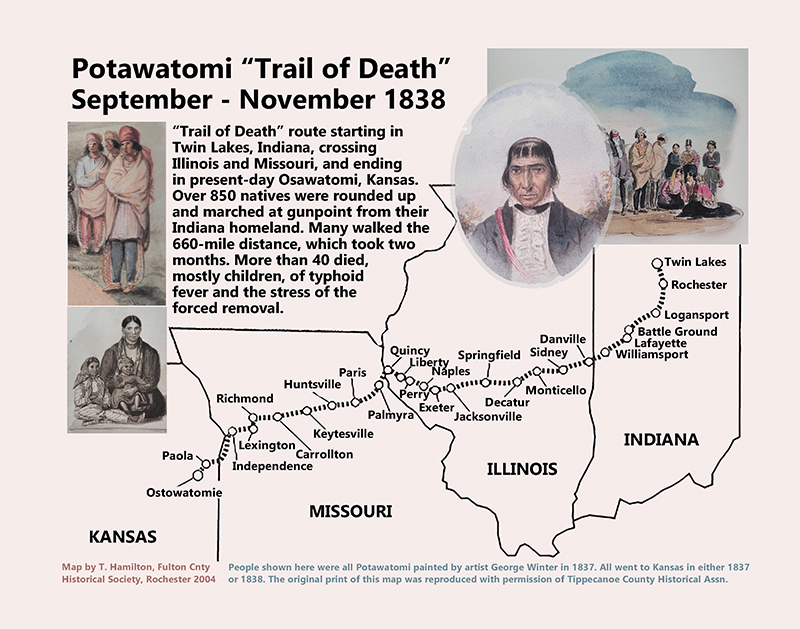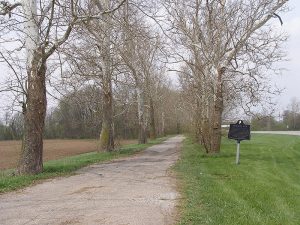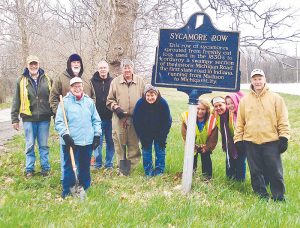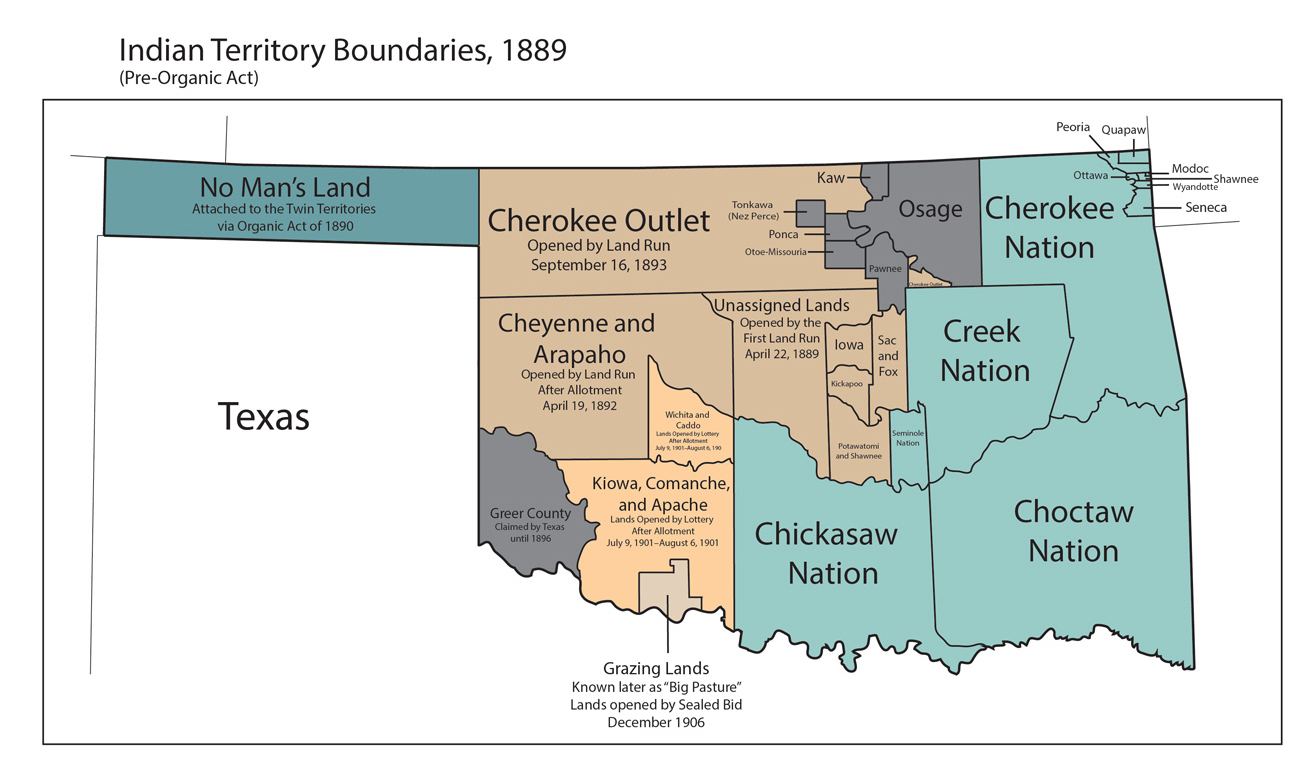The Anishinaabe are the three original tribes of Michigan
The oldest brother, Chippewa, was Keeper of the Faith. * The middle brother, Ottawa, was Keeper of the Trade. * The youngest brother, Potawatomi, was Keeper of the Fire.

This website has a variety of pieces on the Potawatomi and their beginnings, from the eastern United States to Oklahoma, with several hundred years here in Indiana, including the area that would become known as Pulaski County.

This piece connects to the Potawatomi today, the Citizen Potawatomi, and the Citizen Potawatomi Nation Cultural Heritage Center. This piece is liberally borrowed from that website: https://www.potawatomi.org/blog/2018/03/08/prophetic-wisdom-the-first-of-11-new-exhibits-the-seven-fires-sets-tribe-on-path-to-its-future/.
Paintings by: Jennifer Randell, artist and Citizen Potawatomi Nation Cultural Heritage Center’s Eagle Aviary director.
The 7 Fires
The Anishinaabe were visited by seven prophets. Each prophet spoke of a fire, an era that they would endure. Each fire drastically changed their way of life.
 The First Fire
The First Fire
The first fire (turtle) urged the Anishinaabe to leave their home (now Eastern Canada and northeaster United States). They were to move west until they reached the land where food grows on water. If not, they would be destroyed.
 The Second Fire
The Second Fire
The second fire (two otters) represents the time they were without direction. The birth of a boy showed them the correct path.
 The Third Fire
The Third Fire
The third fire (pike) represents their arrival at the Great Lakes region, where they found wild rice growing on the water. They lived in what is now Lower Michigan, then moved to what we know as northern Wisconsin. Eventually they settled into northern Indiana and central Illinois.
 The Fourth Fire
The Fourth Fire
The fourth fire (eastern massasauga rattlesnake) foretold the confrontation with a light-skinned race. The prophet said this race would have the face of a friend or a foe, but they would have trouble differentiating between the two. This is illustrated in the conflicting alliances the Potawatomi made during the French & Indian War, the Revolutionary War, the War of 1812, and the Battle of Tippecanoe.

 The Fifth Fire
The Fifth Fire
The fifth fire (bear) foretold a time of much hardship. The loss of old teachings, an abandonment of traditions and an acceptance of false truths caused long-term negative consequences. The bear represents the sacrifices made by the Potawatomi people to keep whole, healthy, and together as a community. It was during this time that the Potawatomi were removed from Indiana, the time of the Trail of Death.
Side Stories Regarding Their Time In The Fifth Fire
This website has information about this period of time, but for extremely interesting reading, check out Untold Indiana, the Indiana Historical Bureau: https://blog.history.in.gov/recentering-the-potawatomi-at-sycamore-row-part-one/.

The good folks of Carroll County, to our south, in conjunction with the Indiana Historical Bureau, have recentered their story about Sycamore Row.
“The sycamore trees lining the Old Michigan Road have long been the subject of much curiosity and folklore in Carroll County. But there is a story here of even greater historical significance – the removal and resistance of the Potawatomi. While the trees will likely continue to be the subject that brings people to this marker, IHB hopes to recenter the Potawatomi in the story.”

While Part 1 of the Carroll County story focuses on Sycamore Row, Part 2 tells the story of the Potawatomi. While the story is told on our website, the Indiana Historical Bureau does it much better! https://blog.history.in.gov/tag/potawatomi/
 The Sixth Fire
The Sixth Fire
The sixth fire (muskrat) revealed the deception of false promises. Children were taken away to boarding schools, and most did not learn traditional teachings. This caused the near extinction of Anishinaabe culture and history.
Side Information Regarding Their Time In The Sixth Fire
 The Trail of Death took the Potawatomi to Kansas. They were later removed to Indian Territory (what is now Oklahoma).
The Trail of Death took the Potawatomi to Kansas. They were later removed to Indian Territory (what is now Oklahoma).
From the following website: https://www.potawatomi.org/blog/2014/07/08/the-illegal-annexation-of-tribal-land-by-the-city-of-shawnee/
On February 27, 1867, dozens of Citizen Potawatomi Tribal members gathered on their reservation on the Kansas River and signed a treaty establishing the conditions for the Tribe’s removal from Kansas to Indian Territory. These headmen and other respected leaders were not strangers to displacement or dispossession. The Potawatomi were first removed from their ancestral homelands in the Great Lakes region in the 1830s to new territory west of the Mississippi River. Roughly a decade later they were again forced from lands the federal government promised would be their homes forever and moved to a new reservation in northeast Kansas. These experiences prepared the Citizen Potawatomi for the inevitable hardships that resulted from uprooting their families and starting over in a new place.
After signing the treaty, Tribal leaders and officials of the Office of Indian Affairs agreed that a delegation of Citizen Potawatomi would travel to Indian Territory and select a tract of land, not exceeding thirty square miles, which would become the Tribe’s new home. The treaty stipulated that the Tribe would buy the new reservation with proceeds from selling their “surplus” lands in Kansas.
In the winter of 1869 a group of Citizen Potawatomi traveled to Indian Territory and selected a tract of land in the center of the territory to become the site of the Citizen Potawatomi reservation. They ultimately paid $119,790 for the land. Tribal members had to save money to fund their own relocation and finalize their affairs in Kansas, so the earliest families to make the journey to their new reserve arrived in Indian Territory in 1872.
For almost twenty years the Citizen Potawatomi worked the land and struggled to survive and flourish in the challenging conditions of Indian Territory. In 1890, the federal government derailed those efforts by forcing the Citizen Potawatomi and other tribes in the area to participate in the allotment process, legislated by the Dawes Act of 1887. This act dictated that the Citizen Potawatomi accept individual allotments of land. Those lands that remained unallotted were then purchased at a rate far below the fair-market value and classified as “surplus” so it could be opened for non-Indian settlement.
On the morning of Tuesday, September 22, 1891, more than twenty thousand non-Indian settlers gathered on foot, horseback, and with wagons for the starting pistol of the Land Run of 1891. They hoped to claim one of the seven thousand available plots, each one hundred and sixty acres in size. At noon, the pistol fired.
More than half of the original 900 square mile Citizen Potawatomi reservation, approximately three hundred thousand acres, disappeared overnight. What had been legally purchased less than twenty-five years before was simply given away by the U.S. government.
 The Seventh Fire
The Seventh Fire
The seventh fire (eagle) told of a generation when the Anishinaabe language, teachings and culture experienced revival. Eagles are sacred to the Potawatomi because of the promise and hope they signify.
Historical Timeline
The Potawatomi have centuries of tradition, all here on soil that is now the United States of America. This timeline begins with the 1400s, when Europeans encountered the culture and began a written history, and continues to today.
https://www.pbpindiantribe.com/timeline/
The Series
- Indigenous Peoples of Pulaski County
- The Land, From Ice To European Arrival
- The People, From Ice To European Arrival
- Europeans Arrive
- French Fur Trade & The Beaver Wars
- Indian Wars, Pre-Revolutionary War (The Colonial Wars)
- Revolutionary War
- Indian Wars, Post-Revolutionary War
- United States Takes Shape
- Indiana Takes Shape
- Pulaski County Takes Shape
- Indian Removals, 1700 – 1840
- The Potawatomi, Keepers Of The Fire
- Trail Of Death
- The Chiefs Winamac
- 7 Fires of the Anishinaaabe
